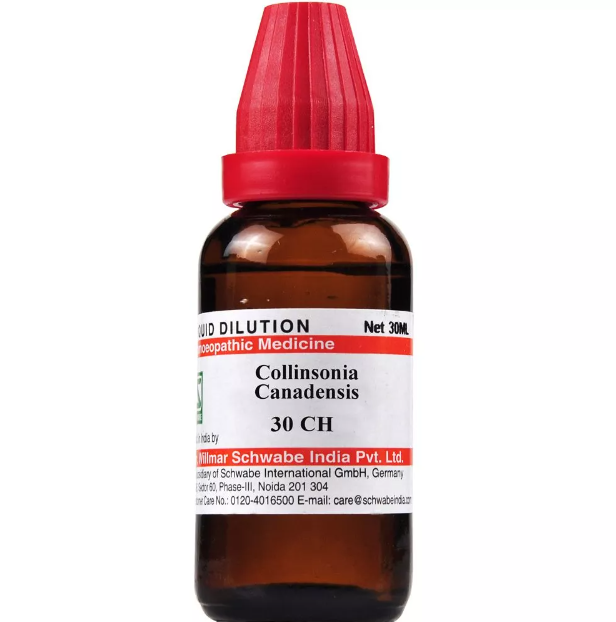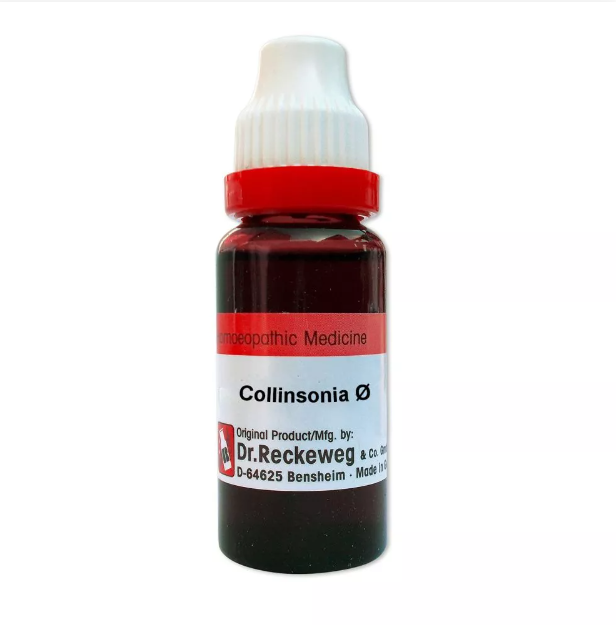COLLINSONIA CANADENSIS Q, 6C, 12C, 30C, 200C, 1M, 10M USES AND SYMPTOMS
 Collinsonia Canadensis
Collinsonia Canadensis
(Stone Root)
Coll.
Pelvic and portal congestion leading to hemorrhoids and constipation, especially in women. Low arterial tension and general muscle weakness. Chronic nasal, gastric, and pharyngeal catarrh due to portal obstruction. Dropsy from heart disease. Itching during pregnancy with hemorrhoids. Constipation in children from intestinal atony. Particularly useful before surgery for rectal diseases. Sensation of weight and constriction. Venous engorgement.
Head: Dull frontal headache from suppressed hemorrhoids. Chronic catarrh.
Mouth: Yellow-coated tongue. Bitter taste (Coloc., Bry.).
Rectum: Sensation of sharp sticks in the rectum. Sense of constriction. Vascular engorgement of the rectum. Dry feces. Stubborn constipation with protruding hemorrhoids. Aching in the anus (proctitis) and hypogastrium. Constipation during pregnancy with membranous dysmenorrhea, following labor (Nux-v.). Painful, bleeding piles. Dysentery with tenesmus. Alternating constipation and diarrhea with great flatulence (dyspepsia). Itching in the anus (Teucr., Rat.).
Female: Dysmenorrhea; vulvar itching; uterine prolapse; swelling and dark redness of genitals; pain when sitting. Membranous dysmenorrhea with constipation. Cold feeling in the thighs after menstruation. Sensation of swelling in the labia and clitoris.
Respiratory: Cough from overuse of voice, “minister’s sore throat”; sharp pain in the larynx. Hoarseness. Persistent dry cough.
Heart: Palpitations; rapid but weak pulse. Dropsy. After heart symptoms improve, hemorrhoids or menstruation return (metastasis). Chest pains alternate with hemorrhoids. Oppression, faintness, and dyspnea (Acon-f.). Heart murmurs.
Modalities: Worse from the slightest mental emotion or excitement, cold. Better with heat.
Relationship: Antidote: Nux-v. Compare: Aesc., Aloe, Ham., Lycps-v., Neg., Sulph., Nux-v.
Dose: Tincture to third attenuation. Higher potencies for organic heart conditions.
SYMPTOMS OF COLLINSONIA CANADENSIS
Head:
Dull frontal headache from suppressed hemorrhoids
Chronic catarrh
Mouth:
Yellow-coated tongue
Bitter taste (Coloc., Bry.)
Rectum:
Sensation of sharp sticks in the rectum
Sense of constriction
Vascular engorgement of the rectum
Dry feces
Stubborn constipation with protruding hemorrhoids
Aching in the anus (proctitis) and hypogastrium
Constipation during pregnancy with membranous dysmenorrhea, following labor (Nux-v.)
Painful, bleeding piles
Dysentery with tenesmus
Alternating constipation and diarrhea with great flatulence (dyspepsia)
Itching in the anus (Teucr., Rat.)
Female:
Dysmenorrhea
Vulvar itching
Uterine prolapse
Swelling and dark redness of genitals
Pain when sitting
Membranous dysmenorrhea with constipation
Cold feeling in the thighs after menstruation
Sensation of swelling in the labia and clitoris
Respiratory:
Cough from overuse of voice (“minister’s sore throat”)
Sharp pain in the larynx
Hoarseness
Persistent dry cough
Heart:
Palpitations; rapid but weak pulse
Dropsy
Return of hemorrhoids or menstruation after heart symptoms improve (metastasis)
Chest pains alternating with hemorrhoids
Oppression, faintness, and dyspnea (Acon-f.)
Heart murmurs
Modalities:
Worse from the slightest mental emotion or excitement, cold
Better with heat
selection of the potency
Individualization:
- Homeopathy is based on the principle of treating the individual, not just the disease. The unique symptoms and characteristics of the person are crucial in determining the most suitable potency.
Intensity of Symptoms:
- The intensity of the symptoms guides the choice of potency. If the symptoms are intense and acute, a lower potency (e.g., 6C, 30C) might be considered. For chronic conditions with less intensity, higher potencies (e.g., 200C, 1M) may be appropriate.
Sensitivity of the Patient:
- Some individuals are more sensitive to homeopathic remedies, while others may require higher potencies. The practitioner considers the patient’s sensitivity when selecting the potency.
Acute vs. Chronic Conditions:
- Lower potencies are often used for acute conditions, while higher potencies may be considered for chronic or long-standing issues.
Previous Response to Potencies:
- The patient’s response to previous homeopathic treatments helps guide the choice of potency. If a particular potency has been effective in the past, it may be repeated or adjusted as needed.
Vital Force and Susceptibility:
- Homeopathy views illness as a disturbance in the vital force. The practitioner assesses the patient’s overall vitality and susceptibility to determine the appropriate potency.
Aggravation or Amelioration:
- The direction of the symptom response (aggravation or amelioration) after taking a remedy can influence the choice of potency.
Miasmatic Considerations:
- In classical homeopathy, the concept of miasms (inherited disease tendencies) is considered. The practitioner take this into account when selecting the potency.
Practitioner Experience:
- The experience and preference of the homeopathic practitioner play a role. Some practitioners may have success with certain potencies based on their clinical experience.
SAFETY INFORMATION
- Do not exceed the recommended dose by physician
- Keep out of the reach of children
- Store in a cool dry place away from direct sunlight
- Maintain half an hour gap between food/drink/any other medicines and homoeopathic medicine
- Avoid any strong smell in the mouth while taking medicine e.g. camphor, garlic, onion, coffee, hing
Medicine images use for reference only selection of homeopathic medicine depends on the individual’s specific symptoms and overall constitution. Moreover, homeopathy is a holistic system of medicine that treats the individual as a whole. In addition to addressing the physical symptoms, it takes into account the emotional and mental state of the person. Consequently, it’s crucial to consult with a qualified homeopathic practitioner for personalized treatment.
The information provided on this website is intended solely for educational purposes. Always seek the advice of your physician or other qualified health provider.
